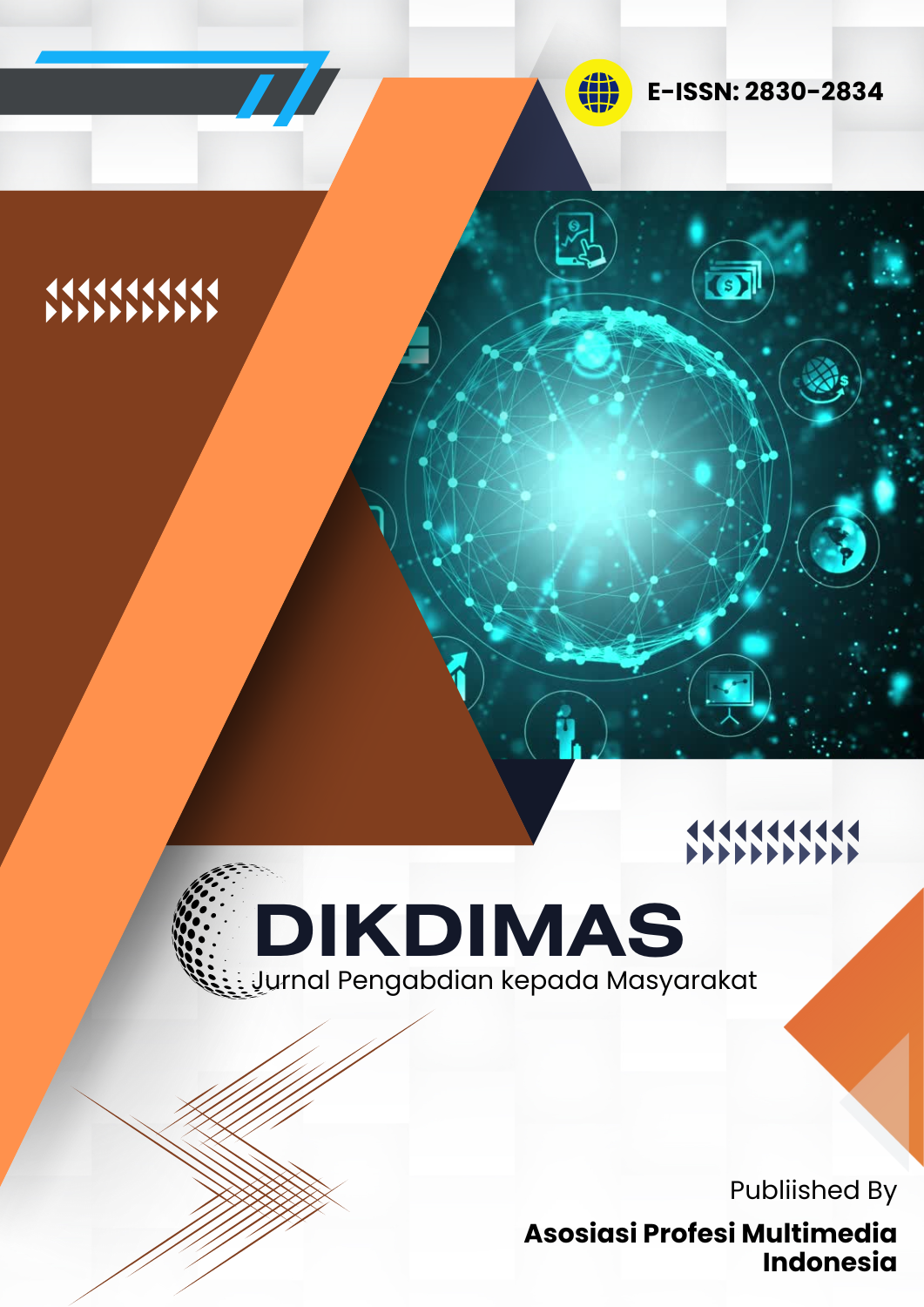Empowerment of Cadres in Early Detection of Stunting Risk During Pregnancy
Main Article Content
Abstract
In general, the aim of community service activities is to increase the knowledge of cadres and pregnant women about early detection of the risk of stunting as an effort to reduce the incidence of stunting. The method of implementing this service activity is carried out by forming a Stunting Care Cadre Group that can carry out early detection of stunting risk during pregnancy in Banjarsari Village, Enggano District, North Bengkulu Regency. In this activity, a pre-test, health education about early detection of stunting risk during pregnancy, after which a Post test was carried out to see if there was an increase in knowledge and skills of cadres in conducting early detection of stunting risk during pregnancy directly in pregnant women. As a result of training and cadre empowerment activities, there is an increase in the knowledge of stunting care cadre groups in Banjarsari Village, Enggano District with an average Pre-test score of 73.2 and an average Post-test score of 88.2, the average increase in knowledge score is an increase of 5.0 The implementation of Cadre Empowerment in Early Detection of Stunting Risk During Pregnancy, there is an increase in knowledge, the formation of an organizational structure of stunting care cadre groups in the village Banjarsari, Enggano District, North Bengkulu Regency. It is hoped that this community service activity can increase knowledge, skills and motivation for cadres and pregnant women to carry out Early Detection of Stunting Risk During Pregnancy.
Downloads
Article Details
Copyright (c) 2024 Elly Wahyuni, Mariati Mariati, Rialike Burhan, Ratna Dewi

This work is licensed under a Creative Commons Attribution-ShareAlike 4.0 International License.
- Authors retain copyright and acknowledge that the Journal of Multidisciplinary Applied Natural Science is the first publisher, licensed under a Creative Commons Attribution License.
- Authors are able to enter into separate, additional contractual arrangements for the non-exclusive distribution of the journal's published version of the work (e.g., post it to an institutional repository or publish it in a book), with an acknowledgment of its initial publication in this journal.
- Authors are permitted and encouraged to post their work online (e.g., in institutional repositories or on their website) prior to and during the submission process, as it can lead to productive exchanges and earlier and greater citation of published work.
References
Akrim, Sulasmi, E., Eriska, P., & Hidayat, F. P. (2020). Kampus Merdeka di Era new Normal Ditinjau dari Perspektif Ilmu Pengetahuan. In Book Chapter Covid 19 & Kampus Merdeka di Era new Normal Ditinjau dari Perspektif Ilmu Pengetahuan (Vol. 4). Google Scholar
Ayun, E. Q., Wati, N., Kosvianti, E., & Febriawati, H. (2024). Studi Fenomenologi Pengalaman Ibu Dengan Balita Stunting Di Wilayah Kerja Puskesmas Made Kota Surabaya. Al-Su’aibah Midwifery Journal, 2(1), 8–19. https://doi.org/10.69597/amj.v2i1.16
Desnita, E., Saputra, N., & Sari, Y. K. (2023). Hubungan Pengetahuan Ibu Terhadap Pencegahan Stunting di Wilayah Kerja Puskesmas Gunung Kota Padang Panjang. Literasi: Jurnal Pengabdian Masyarakat Dan Inovasi, 3(1), 69–74. https://doi.org/10.58466/literasi.v3i1.778
Ibrahim, I., Mas Rukin, & Sulyana Dadan. (2024). Pengetahuan tentang Stunting pada Pasangan Usia Subur (PUS) di Kabupaten Banyumas Kelurahan Mersi. Al-Ubudiyah: Jurnal Pendidikan Dan Studi Islam, 5(1), 236–248. https://doi.org/10.55623/au.v5i1.301
Istiqomah, D. W. N., Utami, T., & Sunesti, Y. (2024). Efektivitas Pengalokasian Dana Desa terhadap Program Percepatan Penurunan Stunting. Kaganga:Jurnal Pendidikan Sejarah Dan Riset Sosial Humaniora, 7(1), 607–623. https://doi.org/10.31539/kaganga.v7i1.9352
Jannah, M., & Nadimin. (2021). Riwayat Kekurangan Energi Kronis (Kek) Pada Ibu Dan Kejadian Stunting Pada Balita Di Wilayah Kerja Puskesmas Turikale. Media Kesehatan Politeknik Kesehatan Makassar, 16(2), 343–352. https://doi.org/10.32382/medkes.v16i2.2421
Komalasari, Supriati, E., Sanjaya, R., & Ifayanti, H. (2020). Faktor-Faktor Penyebab Kejadian Stunting Pada Balita. Jurnal Ilmiah Kebidanan Imelda, 1(2), 45–49. https://doi.org/10.47679/makein.202010
Manapa, E. S., Ahmad, M., Nontji, W., Soraya Riu, D., & Hidayanti, H. (2020). Development of Stunting Risk Detection Module on Pregnant Mother Knowledge. Jurnal Ilmiah Kebidanan, 7(2), 62–75. https://doi.org/10.35316/oksitosin.v7i2.660
Prafitri, L. D., Suparni, S., & Setianto, G. (2024). Pendampingan Ibu Hamil Dalam Upaya Deteksi Dini Resiko Tinggi Kehamilan. Journal of Community Development, 5(3), 423–433. https://doi.org/10.47134/comdev.v5i3.287
Purwati. (2022). Analisis Konsumsi Pangan dan Pendapatan Rumah Tangga Peserta Program Pekarangan Pangan Lestari (P2L) di Kota Pekanbaru [Thesis, Universitas Islam Riau]. Google Scholar
Ramlah, U. (2021). Gangguan Kesehatan Pada Anak Usia Dini Akibat Kekurangan Gizi Dan Upaya Pencegahannya. Ana’ Bulava: Jurnal Pendidikan Anak, 2(2), 12–25. https://doi.org/10.24239/abulava.vol2.iss2.40
Rofiki, I., & Famuji, S. R. R. (2020). Kegiatan Penyuluhan dan Pemeriksaan Kesehatan untuk Membiasakan PHBS bagi Warga Desa Kemantren. Dinamisia : Jurnal Pengabdian Kepada Masyarakat, 4(4), 628–634. https://doi.org/10.31849/dinamisia.v4i4.3992
Sutrio, S., Muliani, U., & Novika, Y. (2021). Pemberdayaan Kader Posyandu dalam Deteksi Dini Kejadian Stunting di Desa Sidodadi Kecamatan Teluk Pandan Kabupaten Pesawaran. Jurnal Abdi Masyarakat Indonesia, 1(2), 427–434. https://doi.org/10.54082/jamsi.143
Yorita, E., Dahrizal, D., Sahidan, S., Gustina, M., Wahyudi, A., Muslim, Z., & Ardiansyah, S. (2023). Upaya Pencegahan Stunting melalui Pengolahan Makanan Berbasis Ikan pada Balita di Pulau Enggano, Kabupaten Bengkulu Utara. Poltekita: Jurnal Pengabdian Masyarakat, 4(1), 132–139. https://doi.org/10.33860/pjpm.v4i1.1445
Yuniawati, R. A. (2023). Tantangan Stunting di Wilayah Pedesaan: Upaya Percepatan Penurunan Angka Stunting di Desa Langkap, Kabupaten Jember. Jurnal Abdi Masyarakat Nusantara, 1(2), 1–9. https://doi.org/10.61754/jurdiasra.v1i2.46



 Elly Wahyuni
Elly Wahyuni
